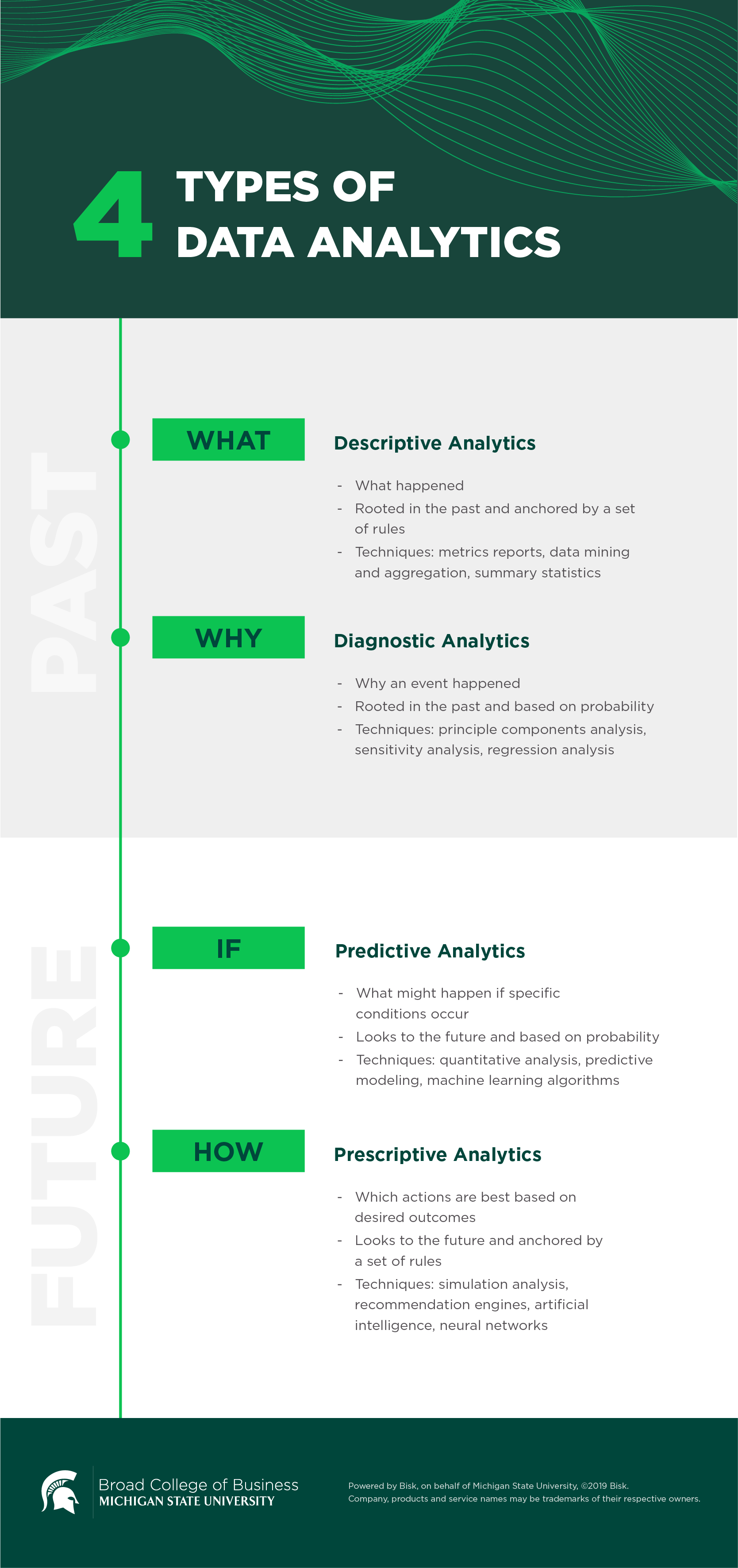4 Types of Data Analytics and How to Apply Them
Last Updated March 28, 2024

Today, organizations across multiple industries have access to more forms of data than ever before, with new data information from multiple sources streaming in by the minute. Whether you’re working in the fields of human resources, marketing, supply chain, accounting and finance, part of a healthcare delivery team, or working in a warehouse or retail setting, increasingly your professional life will be surrounded by and driven by data.
The question for many is how to turn this often random, unstructured data into useable information that can inform business decisions? The answer is by leveraging big data analytics.
By working the data through the complete business analytics cycle, the data’s applications will naturally fall into four types or categories of analytics, depending on the question it helps to answer. These four types of data analytics can equip organizational strategist and decision makers to:
- Describe past results
- Diagnose why past results occurred
- Predict what might happen in the future
- Recommend actions for the organization’s next steps
Armed with deeper insights and informed recommendations, you can gain a better understanding of your business’s performance as a whole and make better decisions as a result.
What Happened: Descriptive Analytics
This type of analytics is rooted in facts, so think of descriptive analytics as the “just the facts, ma’am” basics: the reports that outline measures, like performance metrics, and provide the background for most business intelligence (BI) tools and dashboards.
For example, a canned (fixed) report provided by your sales team may include information on new clients, win rates and goals. You may also use an ad-hoc report to customize the data view to look at only specific data to answer a specific question, such as “How many customers do we have in Florida?” and “How much volume did we sell last month in the Florida territory?”
Descriptive analytics can serve as that starting point or base for building your analytics strategy, with some professionals estimating that 80% of business analytics involve descriptions based on aggregations of past performance. Techniques like data aggregation, data mining, clustering and/or summary statistics all serve to provide analytics that describe a past state—descriptive analytics.
Why Did it Happen: Diagnostic Analytics
Like descriptive analytics, diagnostic analytics also focus on the past. However, these types of analyses look for cause and effect to illustrate why something occurred. The objective is to compare past occurrences to determine causes. Of course, this is seldom a black-and-white answer, but instead provided in the context of probability, likelihood or a distributed outcome.
Diagnostic analytics can provide guidance by helping to:
- Identify outliers. For example, a sudden drop in sales or an explosion in website traffic that can’t be explained may indicate a need for additional examination.
- Isolate patterns. Analysts may need to look outside the existing dataset to identify the source of the pattern. For example, a sudden drop in sales may have stemmed from the launch of a disruptor.
- Uncover relationships. Using more complex analytics, analysts may employ probability theory, regression analysis, or time series to isolate cause and effect relationships.
To determine a “why” from your data, applying such techniques as principle components analysis, sensitivity analysis and training algorithms for classification and regression analysis can all provide a diagnosis—diagnostic analytics.
What Happens If: Predictive Analytics
Predictive analytics is where you start turning the outcomes of your descriptive and diagnostic analytics into actionable insights for decision making by forecasting “potential future outcomes.”
In predicting future outcomes, predictive analytics isn’t making a judgement on whether or not an event is likely to happen, such as, “Will a new competitor join the marketplace?” but instead is describing what will happen if these conditions are met, i.e. “Based on what happened in 2016 when a disruptor joined the marketplace, our sales could decline by 20%.” The goal is determining a trend, correlation, causation or probability.
With predictive analytics, a data analyst uses quantitative analysis of the dataset and establishes predictions, often called predictive modeling. This is a broader approach, which aims to characterize predictions, examining models for their accuracy. Confidence intervals, T statistics, K-S statistics and P values are all part of the umbrella of predictive analytics, applied in machine learning algorithms, classification models and regression models, to name some examples.
Building these models requires expertise, typically from data scientists, machine learning experts or other data analytics specialists working under a data analytics manager.
How to Make it Happen: Prescriptive Analytics
Prescriptive analytics builds on predictive analytics by helping determine recommended (prescribed) actions based on desired potential (predicted) outcomes, helping organizations achieve their business objectives.
Prescriptive analytics models are constantly “learning” through feedback mechanisms to continuously analyze action and event relationships and recommend the optimal solution. By simulating the solution, prescriptive analytics can examine all the key performance criteria to ensure the outcome would achieve the correct metric goals before anything is implemented.
Artificial intelligence, machine learning and neural network algorithms are often employed to support prescriptive analytics by helping to make specific suggestions based on nuanced patterns and perceptions of organizational goals, limitations and influencing factors.
In the wider view of applying business analytics for organizational success, prescriptive analytics “delivers business value through recommendations” built on the data of results.
These four types of analytics help organizations understand and learn from past patterns and performance in order to improve predictions and actions for the future. Understanding and knowing when to apply the appropriate form of analytics to answer the appropriate business questions can help you to develop needed business solutions and gain a competitive advantage.
Master these complex analytical approaches by advancing your business analytics knowledge and skill sets with MSU’s online Business Analytics Certificates, featuring two program tracks.



